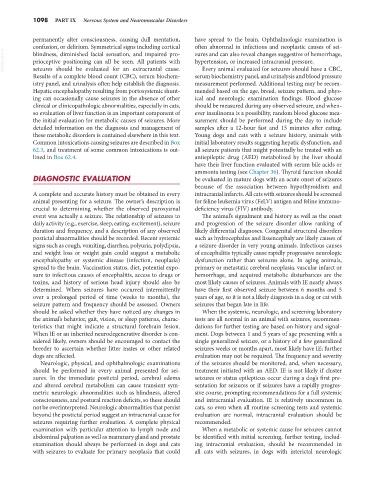Page 1126 - Small Animal Internal Medicine, 6th Edition
P. 1126
1098 PART IX Nervous System and Neuromuscular Disorders
permanently alter consciousness, causing dull mentation, have spread to the brain. Ophthalmologic examination is
confusion, or delirium. Symmetrical signs including cortical often abnormal in infectious and neoplastic causes of sei-
VetBooks.ir blindness, diminished facial sensation, and impaired pro- zures and can also reveal changes suggestive of hemorrhage,
hypertension, or increased intracranial pressure.
prioceptive positioning can all be seen. All patients with
Every animal evaluated for seizures should have a CBC,
seizures should be evaluated for an extracranial cause.
Results of a complete blood count (CBC), serum biochem- serum biochemistry panel, and urinalysis and blood pressure
istry panel, and urinalysis often help establish the diagnosis. measurement performed. Additional testing may be recom-
Hepatic encephalopathy resulting from portosystemic shunt- mended based on the age, breed, seizure pattern, and phys-
ing can occasionally cause seizures in the absence of other ical and neurologic examination findings. Blood glucose
clinical or clinicopathologic abnormalities, especially in cats, should be measured during any observed seizure, and when-
so evaluation of liver function is an important component of ever insulinoma is a possibility, random blood glucose mea-
the initial evaluation for metabolic causes of seizures. More surement should be performed during the day to include
detailed information on the diagnosis and management of samples after a 12-hour fast and 15 minutes after eating.
these metabolic disorders is contained elsewhere in this text. Young dogs and cats with a seizure history, animals with
Common intoxications causing seizures are described in Box initial laboratory results suggesting hepatic dysfunction, and
62.3, and treatment of some common intoxications is out- all seizure patients that might potentially be treated with an
lined in Box 62.4. antiepileptic drug (AED) metabolized by the liver should
have their liver function evaluated with serum bile acids or
ammonia testing (see Chapter 36). Thyroid function should
DIAGNOSTIC EVALUATION be evaluated in mature dogs with an acute onset of seizures
because of the association between hypothyroidism and
A complete and accurate history must be obtained in every intracranial infarcts. All cats with seizures should be screened
animal presenting for a seizure. The owner’s description is for feline leukemia virus (FeLV) antigen and feline immuno-
crucial to determining whether the observed paroxysmal deficiency virus (FIV) antibody.
event was actually a seizure. The relationship of seizures to The animal’s signalment and history as well as the onset
daily activity (e.g., exercise, sleep, eating, excitement), seizure and progression of the seizure disorder allow ranking of
duration and frequency, and a description of any observed likely differential diagnoses. Congenital structural disorders
postictal abnormalities should be recorded. Recent systemic such as hydrocephalus and lissencephaly are likely causes of
signs such as cough, vomiting, diarrhea, polyuria, polydipsia, a seizure disorder in very young animals. Infectious causes
and weight loss or weight gain could suggest a metabolic of encephalitis typically cause rapidly progressive neurologic
encephalopathy or systemic disease (infection, neoplasia) dysfunction rather than seizures alone. In aging animals,
spread to the brain. Vaccination status, diet, potential expo- primary or metastatic cerebral neoplasia, vascular infarct or
sure to infectious causes of encephalitis, access to drugs or hemorrhage, and acquired metabolic disturbances are the
toxins, and history of serious head injury should also be most likely causes of seizures. Animals with IE nearly always
determined. When seizures have occurred intermittently have their first observed seizure between 6 months and 5
over a prolonged period of time (weeks to months), the years of age, so it is not a likely diagnosis in a dog or cat with
seizure pattern and frequency should be assessed. Owners seizures that began late in life.
should be asked whether they have noticed any changes in When the systemic, neurologic, and screening laboratory
the animal’s behavior, gait, vision, or sleep patterns, charac- tests are all normal in an animal with seizures, recommen-
teristics that might indicate a structural forebrain lesion. dations for further testing are based on history and signal-
When IE or an inherited neurodegenerative disorder is con- ment. Dogs between 1 and 5 years of age presenting with a
sidered likely, owners should be encouraged to contact the single generalized seizure, or a history of a few generalized
breeder to ascertain whether litter mates or other related seizures weeks or months apart, most likely have IE; further
dogs are affected. evaluation may not be required. The frequency and severity
Neurologic, physical, and ophthalmologic examinations of the seizures should be monitored, and, when necessary,
should be performed in every animal presented for sei- treatment initiated with an AED. IE is not likely if cluster
zures. In the immediate postictal period, cerebral edema seizures or status epilepticus occur during a dog’s first pre-
and altered cerebral metabolism can cause transient sym- sentation for seizures or if seizures have a rapidly progres-
metric neurologic abnormalities such as blindness, altered sive course, prompting recommendations for a full systemic
consciousness, and postural reaction deficits, so these should and intracranial evaluation. IE is relatively uncommon in
not be overinterpreted. Neurologic abnormalities that persist cats, so even when all routine screening tests and systemic
beyond the postictal period suggest an intracranial cause for evaluation are normal, intracranial evaluation should be
seizures requiring further evaluation. A complete physical recommended.
examination with particular attention to lymph node and When a metabolic or systemic cause for seizures cannot
abdominal palpation as well as mammary gland and prostate be identified with initial screening, further testing, includ-
examination should always be performed in dogs and cats ing intracranial evaluation, should be recommended in
with seizures to evaluate for primary neoplasia that could all cats with seizures, in dogs with interictal neurologic

